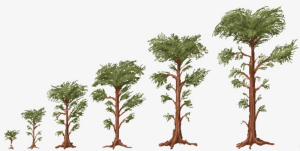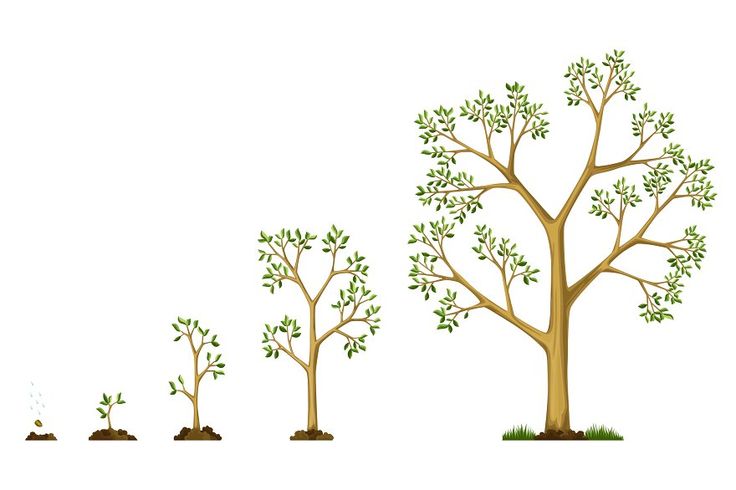How do Trees Grow Taller?
Understanding how trees grow taller is critical for both arborists and tree enthusiasts. From the complicated biological processes within a tree’s cells to the extrinsic variables impacting growth, investigating vertical growth mechanisms provides fascinating insights into the arboreal environment. ArborTrueCA’s comprehensive book delves into the science of tree height, shedding light on the variables that drive vertical development and providing practical advice for growing tall, magnificent trees.
How do trees grow taller?
Benefits of Tall Trees
Tall trees have numerous benefits for both the environment and human culture. Here are some important benefits of towering trees:
Carbon Sequestration: Tall trees collect carbon dioxide from the atmosphere and store it in their biomass, thus contributing to climate change mitigation.
Habitat for Wildlife: Tall trees provide habitat and shelter for a wide variety of wildlife, including birds, mammals, insects, and fungi, which benefits biodiversity and ecosystem health.

Air Quality Improvement: Tall trees release oxygen and filter contaminants from the air through photosynthesis, helping to enhance air quality and public health.
Erosion Control: Tall trees’ large root systems anchor the soil, minimizing erosion and lowering the risk of landslides in sensitive regions.
Aesthetic Value: Tall trees add beauty to landscapes, parks, and urban areas, providing visual interest and a sense of calm for people to enjoy.
Overall, towering trees are vital assets to our world, enriching ecosystems, increasing biodiversity, and offering a variety of ecosystem services required for life.
The Anatomy of Tree Growth
Cell Division and Elongation
At the heart of tree development is the amazing process of cellular division and elongation. Meristematic cells at the terminals of stems and branches constantly divide, producing new cells that lengthen and contribute to vertical growth. This delicate dance of cell division and elongation drives tree growth, allowing them to reach ever-greater heights.
Primary and Secondary Growth
Trees have two forms of growth: primary and secondary. Primary growth takes place in apical meristems, where cells elongate to lengthen stems and branches. Secondary growth, on the other hand, is characterized by the thickening of stems and branches caused by lateral meristem activity, resulting in the development of woody tissue and greater girth.

Apical Dominance
Apical dominance is important for tree growth because it influences the distribution of growth hormones and the development of lateral branches. The terminal bud at the tip of a branch generates auxin, a hormone that suppresses the growth of lateral buds below it, diverting the tree’s energy upward and encouraging vertical expansion.
Factors Influencing Tree Height
Genetics
Genetics plays an important influence in establishing a tree’s greatest height potential. Different tree species have innate genetic characteristics that influence their growth habits, such as maximum height, growth rate, and general shape. Understanding a tree species’ genetic makeup is critical for estimating its growth rates and potential size.
Environmental conditions
Environmental elements such as sunlight, water availability, soil composition, and temperature have a significant impact on tree growth. Adequate sunshine drives photosynthesis and provides energy for growth, whereas water and nutrients taken from the soil are required for cellular activities and structural development. Soil composition affects root growth and nutrient uptake, whereas temperature affects metabolic rates and overall tree health.
Competition
Competition for resources such as sunshine, water, and nutrients can have an impact on tree height in thick woods or congested metropolitan areas. Trees that compete for limited resources may develop at a slower rate or have a lower height than trees that have plenty of resources.
Strategies for Promoting Vertical Growth
Proper Planting
Planting trees in good sites with enough sunlight, well-drained soil, and enough room for root expansion prepares the ground for healthy vertical growth. Avoid planting trees too deeply or in compacted soil, since this can impede root formation and stunt growth.
Pruning
Strategic pruning can promote vertical development by removing competing branches, lowering crown density, and increasing apical dominance. Prune trees during their dormant season to reduce stress and increase the tree’s reaction to pruning.
Fertilization
Applying balanced fertilizers high in critical nutrients can stimulate strong growth and vertical extension. To minimize over-fertilization, use tree-specific fertilizers and adhere to application restrictions.
How long does it take for a tree to reach its maximum height?
The time a tree takes to reach its maximum height varies on tree species environmental conditions, and other factors. Some fast-growing species may reach their maximum height in a few decades, while slow-growing trees may achieve their full height
How Do Trees Grow Taller: Insights for ArborTrueCA
Understanding the complexities of tree growth is critical for arborists looking to grow tall, healthy trees. ArborTrueCA provides tree care professionals with the knowledge and tools they need to sustain healthy arboreal ecosystems by diving into the biological processes, environmental factors, and management tactics that influence tree height. With a strong respect for the miracles of tree growth, ArborTrueCA continues to raise arboricultural standards, promoting healthy trees that reach for the sky.
FAQS
Can pruning stimulate vertical growth in trees?
Strategic pruning can boost vertical development by fostering apical dominance and eliminating competing branches.
How essential is soil quality in determining tree height?
Soil quality has a substantial impact on tree growth, as it influences root formation, nutrient uptake, and overall tree health.
Does every tree species have the same maximum height potential?
No, the maximum height potential of individual tree species varies depending on their genetic features and growth behaviors.
What influence does sunshine have on tree height?
Sunlight is required for photosynthesis, which provides energy for growth and promotes the formation of strong, healthy stems and branches.
How do I promote vertical growth in newly planted trees?
Proper planting, trimming, and fertilizer procedures can help stimulate vertical development in recently planted trees.
Conclusion
Finally, understanding how trees grow taller reveals the complicated mechanisms and ecological relevance that drive their vertical growth. Trees’ upward journey exemplifies nature’s tenacity and complexity, from the intricate processes of cellular division and elongation to the numerous elements that influence development. Arborists and tree enthusiasts can get useful insights into supporting healthy, thriving ecosystems by investigating the genetic, environmental, and managerial factors that influence tree height. As environmental stewards, it is our job to value and conserve these towering giants, recognizing their important contributions to air quality, biodiversity, and resilience to climate change. With proper care and maintenance, big trees can continue to stand as majestic sentinels of nature, enhancing our lives and the earth for future years.




